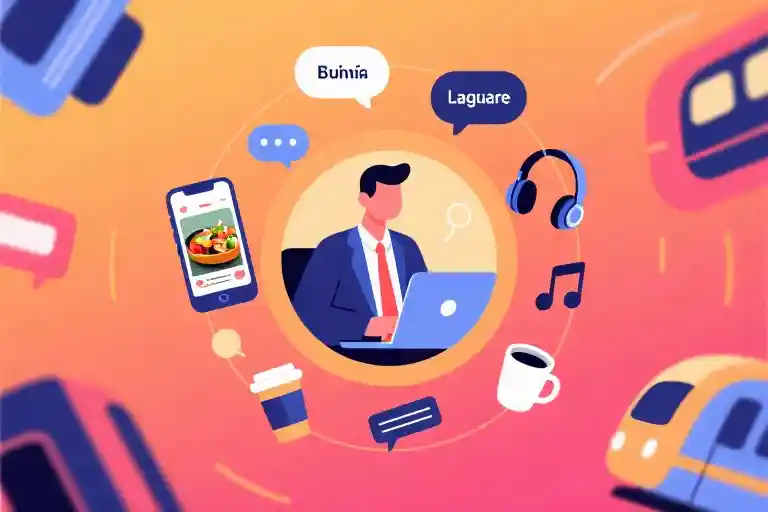The idea that language learning requires hours of tedious grammar drills is about as outdated as a flip phone. Yet this persistent myth keeps countless potential polyglots trapped in textbook purgatory, convinced they lack the discipline or time to master another tongue.
Here’s the liberating truth: fluency doesn’t demand monastic study habits. What if becoming conversational in Spanish, French or Mandarin could happen as effortlessly as scrolling through your morning Instagram feed? The secret lies in hijacking your existing routines – those scattered 15-minute pockets between meetings, during commutes, or while waiting for your coffee to brew.
Modern neuroscience confirms what savvy language hackers have known for years: consistent micro-exposures to a language create deeper neural pathways than occasional marathon study sessions. When you encounter vocabulary through emotionally charged contexts (like laughing at a German meme or cursing a collapsed soufflé), your brain prioritizes retention. This explains why you remember lyrics from a catchy K-pop chorus better than textbook vocabulary lists.
The methods ahead aren’t shortcuts – they’re smart detours around the boredom barrier. By aligning language acquisition with activities you already enjoy (binge-watching, gaming, social media), you create self-sustaining learning loops. Each suggestion follows three design principles:
- Zero added time (parasitic to existing habits)
- Emotional engagement (amusement, curiosity, challenge)
- Contextual learning (words anchored to real situations)
Forget conjugating verbs in isolation. You’re about to discover how absorbing Italian through cooking fails or picking up Japanese from anime subtitles creates a more organic – and ironically more durable – language foundation than any classroom could provide.
Instagram Stalk Your Way to Fluency
Forget flashcards and vocabulary lists. The modern language learner’s secret weapon is already in your pocket – Instagram. When you follow foreign celebrities, influencers, or meme accounts, something magical happens. You start absorbing the living, breathing version of the language that never makes it into textbooks.
Here’s why it works:
- Contextual learning hits different. Seeing slang like “sus” or “glow up” in actual captions with relevant visuals creates stronger neural connections than isolated word memorization. The next time you hear these phrases, your brain will recall that hilarious meme you saw last Tuesday.
- Cultural immersion happens by osmosis. Notice how French influencers kiss cheeks in every photo? How Japanese accounts obsess over seasonal foods? These unspoken cultural rules become obvious through repetition – no anthropology degree required.
- Passive exposure adds up. Even if you just mindlessly scroll during bathroom breaks, your brain is cataloging sentence structures, common hashtags, and reaction phrases. Before you know it, you’ll be thinking “¡Qué guay!” instead of “cool” when something impresses you.
Pro tips for maximum learning:
- Start with meme accounts (universal humor bridges language gaps)
- Follow local influencers in your interest areas (fitness, art, parenting)
- Use the “Save” feature for posts with useful phrases
- Try commenting with emojis first, then short phrases
Warning: You might accidentally pick up questionable fashion advice along with your vocabulary. That neon green tracksuit the Italian nonno influencer swears by? Maybe admire his language skills rather than his wardrobe choices.
Remember: This isn’t about studying – it’s about letting the algorithm work in your favor. Fifteen minutes of targeted scrolling can teach you more practical language than an hour of conjugation drills. #GramYourGrammar
The Art of Café Eavesdropping
Language learners often overlook one of the most effective (and free) resources available: random strangers having conversations in public spaces. While traditional courses have you listening to carefully enunciated dialogues about hotel reservations and train schedules, real people in cafés discuss everything from relationship drama to conspiracy theories about the new coffee machine.
Here’s how to turn your local coffee shop into an immersive language lab:
Positioning is everything
Arrive during peak hours when the background hum creates perfect acoustic cover. Choose a seat equidistant between two lively conversations – close enough to hear, but not so near that you become part of their discussion about last night’s disastrous date. The ideal distance lets you practice selective attention, a crucial skill for real-world listening.
Decode the musicality
Before worrying about vocabulary, tune into the rhythm of natural speech. Notice how questions rise like steam from an espresso cup, or how laughter punctuates stories. Even when you miss words, you’re absorbing the cadence that makes native speakers sound authentic. This unconscious learning mirrors how children acquire language long before they understand grammar rules.
Embrace the fragments
Unlike classroom recordings, real conversations are messy. People interrupt, trail off, and invent words on the spot. That guy complaining about his “glitchy” smartphone? He just created your new favorite adjective. These organic speech patterns reveal how language actually functions – full of shortcuts, improvisations, and cultural references that never appear in textbooks.
The strategic notebook
Resist the urge to scribble constantly. Jot down only:
- Recurring phrases (“No way!” “Seriously?”)
- Context clues (angry tone + “manager” = probably complaining about work)
- Words you can guess from gestures (that dramatic hand flourish probably means “unbelievable”)
Later, reconstruct the conversation’s gist like a linguistic detective. This active processing cements learning far better than passive listening.
When to abort mission
If conversation partners start glancing your way or lowering their voices, you’ve crossed from language learner to creepy listener. Time to suddenly become engrossed in your phone or pretend to notice something fascinating outside the window. Ethical eavesdropping requires respecting the unwritten rules of public space – take the language, but leave their privacy intact.
#SneakyListeningSkills in action
Yesterday’s café session taught me:
- The local pronunciation of “caramel” (3 people said it 3 different ways)
- That the barista definitely dated someone named Marco (based on hissed consonants)
- How people actually respond to “How’s your day?” (Spoiler: not with textbook-perfect sentences)
Unlike scripted audio lessons, these unvarnished interactions reveal the living, breathing heart of a language – complete with its imperfections, inside jokes, and unexpected poetry. Just remember to tip your barista well; they’re essentially your conversation curator.
Cooking Up Language Skills
There’s something about the sizzle of garlic in olive oil that makes vocabulary stick better than flashcards ever could. When you cook in your target language, you’re not just preparing food – you’re marinating your brain in practical, everyday words that most textbooks ignore.
Start with YouTube recipes from native speakers. Search for “[target language] cooking tutorial” and look for creators who speak clearly while showing each step. The visual context bridges gaps when you don’t catch every word. That moment when you realize “émincer” means “to slice thinly” while watching someone chop onions? That neural connection will outlast anything memorized from a vocabulary list.
Measurements become painless conversions – discovering that a “verre à moutarde” (mustard glass) is approximately 1/2 cup in French recipes teaches you both kitchen math and cultural history. Verbs like “whisk,” “simmer,” and “caramelize” transform from abstract concepts to muscle memory when your hands are actually doing the actions.
Then there’s the bonus curriculum no language course officially teaches: creative swearing. When your soufflé collapses or you burn the paella, authentic frustration vocabulary comes roaring in. Spanish chefs have at least fourteen ways to say “it’s ruined” with varying degrees of drama – knowledge you won’t find in any classroom.
Pro tip: Start with dishes you already know how to make. Following familiar recipes in another language creates mental scaffolding – you understand the cooking process, so you can focus on decoding the language. That “aha” moment when you recognize “dorar la cebolla” means “brown the onions” in Spanish? That’s fluency building itself.
Netflix in Micro-Doses: Your Guilt-Free Language Hack
The beauty of language learning through Netflix lies in its built-in accountability system. When you commit to watching exactly half an episode daily, you’re working with the platform’s natural cliffhangers rather than against them. Those 15-20 minutes before the midpoint turn into perfect bite-sized lessons where characters establish context, introduce key vocabulary, and reveal cultural nuances through organic dialogue.
Start with shows you’ve already watched in your native language. Familiarity with the plot removes comprehension pressure, letting you focus on how expressions translate. Switch subtitles to your target language rather than relying on English – this creates crucial text-audio alignment that reinforces word recognition. Notice how characters gesture when speaking certain phrases, how their tone shifts with idioms, and how filler words (those ubiquitous “ums” and “ahs”) differ across cultures.
For Spanish learners, try pausing La Casa de Papel after Professor explains a heist detail. French beginners might stop Emily in Paris just as she commits another cultural faux pas. The partial episode approach prevents binge-induced fatigue while maintaining narrative tension that’ll have you eager for tomorrow’s installment. Unlike textbook dialogues, these authentic interactions teach you how people actually interrupt each other, trail off mid-sentence, and embed humor in everyday speech.
Pro tip: Keep a notepad (or your phone’s notes app) handy to jot down three memorable phrases per viewing. Not full sentences – just vivid fragments you’d want to use yourself, like a sarcastic comeback or an enthusiastic agreement. Next day, challenge yourself to work one into conversation, even if just muttering it to your cat. #HalfBinge becomes #FullFluency faster than you’d think.
Turn Your Commute Into a Karaoke Session
That mind-numbing traffic jam could actually be your secret language learning weapon. Instead of cursing at brake lights, try this: queue up a playlist of catchy songs in your target language and turn your car into a mobile karaoke booth.
Here’s why it works better than you’d think:
- Melody is memory glue – Our brains are wired to retain information set to music. Those embarrassing 90s jingles you can’t forget? Exactly. When vocabulary comes packaged with rhythm and rhyme, it sticks without effort.
- Pronunciation bootcamp – Trying to keep up with native-speed lyrics does wonders for your mouth muscles. You’ll naturally mimic the singer’s articulation, picking up subtle sounds that textbooks can’t teach.
- Contextual learning – Unlike isolated vocabulary lists, songs serve you full phrases with emotional context. You’ll absorb how natives actually express heartbreak, joy, or sarcasm – complete with authentic interjections.
Pro tip: Start with children’s songs or pop ballads (slower tempo, clearer enunciation) before graduating to rap battles. Keep the subtitles on for the first few rounds until your ear adjusts.
Warning: You might develop uncontrollable urges to:
- Air-drum at stoplights
- Explain Slavic folk metaphors to confused passengers
- Perfect your throaty French “r” during merge lanes
But that’s how you know it’s working. #TrafficJamConcert
Change Your Map App’s Language
Here’s a language hack that turns your daily commute into an accidental vocabulary lesson: switch your map app’s interface to your target language. It’s like getting lost on purpose—but with educational benefits.
When your GPS starts barking directions in Spanish or Mandarin, you’ll quickly pick up essential navigation terms without cracking a textbook. That robotic voice saying “Gire a la izquierda en 300 metros” suddenly becomes your impromptu tutor. Within weeks, you’ll internalize directional vocabulary so thoroughly that you might dream about highway exits in your new language.
The magic lies in contextual learning. Unlike memorizing flashcards, seeing “Sortie” flash on your screen while approaching a French highway exit creates neural connections that stick. You’re not just learning words—you’re experiencing them through real-world spatial relationships.
Pro tip: Start this experiment when you’re traveling familiar routes. That way, when the app cheerfully announces “Fahren Sie jetzt links” in German, you won’t actually miss your turn while deciphering it. Though getting slightly lost does intensify the learning experience—nothing cements vocabulary like mild panic when you realize you’ve been following directions to “Nord” instead of “Süd.” #LostAndLearning
For bonus points, combine this with changing your phone’s system language. Suddenly, weather alerts become mini-comprehension tests, and app notifications transform into surprise vocabulary quizzes. It’s the closest thing to language immersion without buying a plane ticket.
Play Foreign Video Games (Badly)
Here’s a confession: I once spent 27 minutes staring at a German dialogue option in The Witcher 3, paralyzed by the terrifying possibility of accidentally romancing a troll instead of buying potions. That’s when I realized gaming in your target language isn’t about winning—it’s about glorious, educational failure.
Switching your game’s language settings might be the sneakiest vocabulary drill ever invented. Action RPGs bombard you with combat terms (Angriff! Heilung!), while narrative games like Life is Strange drip-feed casual conversations. Even getting stuck becomes productive when you’re deciphering quest objectives like “Find the baker’s missing cat” in Portuguese.
Three unexpected benefits emerge:
- Contextual learning sticks better. You’ll never forget the Spanish word for “sword” (espada) after dying to one 15 times.
- Emotional engagement boosts retention. The frustration of misreading “jump” as “surrender” etches corrections into your brain.
- Cultural immersion happens naturally. Japanese honorifics in Persona games teach social nuances no textbook covers.
Pro tip: Start with games you’ve already completed in your native language. Knowing the plot lets you focus on linguistic details. Puzzle games (Portal), life sims (Stardew Valley), and anything with extensive item descriptions (Skyrim) work particularly well.
Warning: You may develop a peculiar accent. My French now carries the dramatic inflection of Assassin’s Creed NPCs, and honestly? #GamerGoals achieved.
Scroll TikTok (With Purpose)
Here’s a confession: most of us already spend 15 minutes daily falling into TikTok rabbit holes. What if those endless scrolls could secretly turn you into a polyglot? The platform’s algorithm is oddly perfect for language acquisition – short clips force creators to use high-frequency vocabulary, exaggerated expressions provide context clues, and before you know it, you’re absorbing sentence structures between dance trends.
Start by following three types of accounts:
- Everyday vloggers showing grocery hauls or commute rants – their unscripted speech reveals how natives actually talk
- Language teachers who explain grammar through memes (search #SpanishTok or #DeutschLernen)
- Cultural commentators discussing local news or trends – you’ll pick up niche terms textbooks ignore
Pro tip: Engage with videos by leaving simple comments in your target language. A “This made me laugh!” or “How do you make this dish?” creates micro-writing practice without pressure. The creator might even reply, giving you bonus reading material.
Warning: You’ll encounter slang that would make your high school teacher faint. Embrace it. Understanding phrases like French “wesh” or Portuguese “é osso” means you’re learning the living language, not some museum-piece version.
TikTokFluency isn’t about diligent study – it’s letting the For You page become your unpredictable, occasionally chaotic tutor. Tomorrow when you inevitably open the app during your coffee break, congratulate yourself: those 15 minutes of procrastination just counted as language immersion.
Text Random Sentences to Friends
Language learning thrives on spontaneity—those unscripted moments when you’re forced to construct thoughts on the fly. That’s why sending absurd, out-of-context messages in your target language might be the most underrated practice method.
Next time your friend texts about weekend plans, reply with something like “My goldfish speaks better French than me” or “I accidentally adopted three llamas” in the language you’re learning. The beauty lies in the confusion it creates. Your friend’s bewildered reaction (“…what?”) forces you to explain yourself, turning a silly exchange into genuine conversational practice.
This technique works because:
- Low-pressure output: Unlike formal speaking exercises, there’s no grading criteria—just playful experimentation
- Contextual learning: You’ll naturally recall phrases relevant to your daily life (e.g., “The coffee machine revolted against me”)
- Memory anchoring: The emotional spike of making someone laugh (or worry about your sanity) cements vocabulary
Pro tip: Create a shared doc with bilingual friends where you can:
- Archive your weirdest sentences for later review
- Let them correct your grammar with colorful commentary
- Turn it into a game—who can craft the most bizarre yet grammatically sound declaration?
Warning: You might permanently alter your text history into a surrealist art project. #RandomActsOfLanguage
The Art of Terrible (But Effective) Meme Translation
Memes have become the universal language of the internet – those perfectly captioned images that make us snort coffee through our noses at 2am. But here’s a secret: making intentionally awful meme translations in your target language might be the most underrated writing practice method out there.
Start simple. Take any basic meme template (think distracted boyfriend, woman yelling at cat, or that smug Wojak face). Now attempt to caption it in your new language using whatever vocabulary you’ve got. The key? Don’t aim for perfection. In fact, embrace the cringe. That bizarre Spanish translation of “They had us in the first half” that makes native speakers recoil? That’s your golden ticket to learning.
Why this works:
- Low-stakes creativity: Unlike formal writing exercises, there’s zero pressure when creating meme garbage. You’re free to experiment with sentence structures without fear of failure.
- Vocabulary cementing: Trying to express “Karen taking to the manager” in German forces you to recall specific nouns and verbs in context.
- Cultural unpacking: When your French meme about baguettes falls flat, you’ll quickly learn what actually resonates with native speakers.
Pro tip: Use free apps like Canva or Imgflip for quick captioning. Share your creations in language learning communities – the corrections and laughter from native speakers become instant feedback. Over time, you’ll notice your meme translations becoming less painfully awkward (though hopefully never completely respectable).
Remember: Every viral meme started as someone’s dumb idea. Your terrible translations today are building the neural pathways for effortless expression tomorrow. #MemeYourWayFluent
The Secret to Effortless Fluency
Those fifteen minutes you spend waiting for coffee, scrolling mindlessly, or zoning out during your commute? That’s your new language lab. The kind where no one makes you conjugate verbs or memorize fruit vocabulary (unless you actually want to know how to say ‘watermelon’ in Portuguese).
What we’ve been getting wrong about language learning is the industrial-era mindset that progress must be measured in textbook chapters completed. Real humans don’t acquire language through conjugation tables—we absorb it through repeated exposure to things we find mildly interesting. The waiter who learned English from Hollywood movies didn’t study script transcripts—he just really wanted to understand why Jack didn’t fit on that door at the end of Titanic.
This is why the meme method works when flashcards fail. Why accidentally ordering tripe instead of tacos burns vocabulary into your brain better than any workbook exercise. Every awkward karaoke session where you butcher Spanish pop lyrics is creating neural pathways no classroom drill ever could.
The magic isn’t in the fifteen minutes—it’s in the fifteen consecutive days. The consistency of micro-exposures that trick your brain into thinking this new language is something you actually need to survive. Like how you somehow know all the lyrics to that one annoying radio hit without ever consciously trying to learn them.
Textbooks have their place, but fluency happens in the spaces between study sessions. In the moments when you’re too distracted to realize you’re learning. When the pressure’s off and your guard is down—that’s when the language sneaks in.
So close the grammar apps. Put down the highlighters. The fastest way to fluency isn’t more studying—it’s more living. Just do it in the language you’re learning.
(And if anyone questions why you’re watching German baking shows at 2am, just say it’s homework. Technically, you’re not wrong.)





